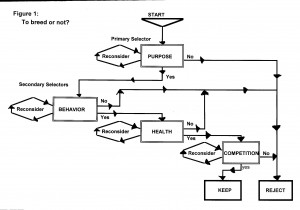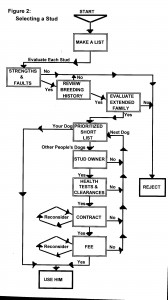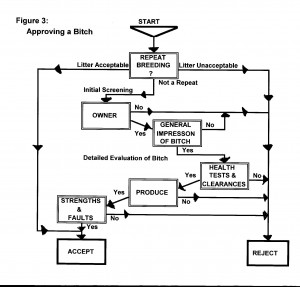A tool for Better Breeding
by C. A. Sharp
First published in Double Helix Network News, Fall 2010
![]()
![]() Note:
Note:![]() Click on graphics to enlarge for easier viewing.
Click on graphics to enlarge for easier viewing.
Top breeders don’t get that way by accident. Each and every breeding is preceded by careful planning drawn from an encyclopedic knowledge of the breed and of individual dogs, past and present. Top breeders have standards that guide their decision-making process and a clear view of what they want to accomplish, not only in individual breedings but with their line of dogs. It requires knowledge, determination and experience.
So how do you, an up-and-coming breeder, get where they are? While accumulating knowledge and gaining experience, you must develop a consistent and thorough evaluation system that will help you select breeding stock or a stud for your bitch and, if you are a stud owner, determine whether or not you want to make him available to a particular bitch. What you need is a decision tree.
Growing a system
A decision tree doesn’t have leaves or roots, but it can sprout branches. It is a graph indicating starting and finishing points, and routes through all the decision points in between, including possible alternate paths to your final decision. For those who learn visually, sketching out a graph like this might prove helpful. Those who are not visual learners may want to develop a different approach, but you still must have a way to work through all the important variables.
Like real trees, your decision trees can be dynamic and changing, as you adjust them to suit new or different needs. You may “grow” a branch here, or prune one there. Do what works for you and be willing to adjust should the need arise. The charts used in this article are basic. You may think of additional decision paths you want included for your own purposes, or want to re-arrange the sequence.
Before you can begin, you have to know your starting point. What are the strengths and weaknesses of each of your breeding dogs? What are your short- and long-term goals as a breeder? You need to consider and prioritize all pertinent issues of conformation, performance, behavior and health.
Pruning
You can’t be a top breeder without quality dogs. You need to evaluate each dog’s worth as a potential breeder either before you buy or, with a puppy, as it matures. One can never know for sure if a puppy will grow into a dog adequate to your breeding needs. Figure 1 is a decision tree chart showing the major decision points for whether or not to keep a puppy for breeding.
The primary selector, your first decision point, is based around your primary goal as a breeder. This might be conformation, some area of performance competition, or even real-world work. Whatever it is, the puppy must meet certain basic criteria for your chosen field or there is no point to keeping it in your breeding program even if it is a stellar individual in all other respects.
Sometimes a puppy may require re-evaluation before a final keep/don’t keep decision is made. It may have some minor conformation faults that could improve with age or not yet be showing sufficient interest in livestock. The loop away from and back to the decision point for the primary breeding goal indicates the potential need to wait a while and re-evaluate.
If the puppy passes muster for your primary selector, you need to move on to several secondary selectors. There should be at least two (behavior and health) but might be more, depending on your particular circumstances, as has been done in Fig. 1.  For example, if your primary area of interest is some sort of competitive event, you want a secondary decision point for that. (Or multiple points if your dogs compete in more than one venue.)
For example, if your primary area of interest is some sort of competitive event, you want a secondary decision point for that. (Or multiple points if your dogs compete in more than one venue.)
While Fig. 1 shows these secondary selectors in a particular sequence you could rearrange the order to something that better suits your own practice. In actuality, you probably will be working on all of these things at once. The purpose of the chart is to focus your thinking so you don’t let superior qualities in one area cloud your evaluation of others: Superb conformation and great temperament are wonderful, but if health screening results are disastrous; the pup ceases to be a good breeding candidate.
A similar chart can be used if you want to evaluate an adult dog you might purchase or leasing. Changes might include additional secondary selectors (evaluating its family members, breeding history.) For an adult dog, you wouldn’t need so many re-evaluation loops; you won’t be waiting for it to grow up and health testing may already have been done.
Pollination
Consider another common breeder’s decision: Selecting a stud for your bitch. (Figure 2) The first thing you need to do is put together a list of possible candidates. Even if you think you want to use a particular dog, going through the process will help you determine whether your prime target actually is the best option for this particular breeding. A secondary benefit of evaluating multiple studs is that you will gather data that may prove helpful in future breeding decisions for this bitch or some other you own.
The first thing you need to do is put together a list of possible candidates. Even if you think you want to use a particular dog, going through the process will help you determine whether your prime target actually is the best option for this particular breeding. A secondary benefit of evaluating multiple studs is that you will gather data that may prove helpful in future breeding decisions for this bitch or some other you own.
Once you have a list, you must research and evaluate each dog. As with the secondary selectors in Fig. 1, these evaluation points might be put in any order and, in actual practice, done concurrently. Study each dog’s strengths and weaknesses. If he’s been bred, what are the qualities and weaknesses of what he’s produced with special attention to whether he throws his own faults or those of your bitch? Finally, and especially important if the dog has not been bred before or his offspring are too young for meaningful evaluation, what strengths and weaknesses are common among his family members, including direct ancestors and their siblings and offspring plus the dog’s full and half siblings and their get.
Once you’ve evaluated all of the dogs, the next decision point on is to develop a prioritized short list of potential sires for your litter.
If you own the dog at the top of this short list, your decision is made. If not the key decision point is the dog’s owner: Is this someone you are willing to do business with? If yes, then have the necessary health clearances been done? (In this author’s opinion, any dog at public stud should have had every test available for the breed and be current on those, like eye exams, that must be repeated.)
If health evaluations are in order and complement those of your bitch (you wouldn’t want to breed two carriers of a recessive health issue to each other) it is time for business negotiations: The contract and the fee. The stud owner will provide you with a contract and tell you the stud fee. If either is a problem for you, you may be able to negotiate a more acceptable deal, hence the reconsideration loops.
If you run into something unacceptable at any of these points you return to your short list and start the process over with the next dog.
Planting seed
The final decision tree example (Fig. 3 ) puts the breeding shoe on the other foot: Screening bitches for your stud dog. Everything else depends on the answer to this question: Has this particular mating been done before and, if so, what happened? There are three possible answers. Yes and the litter was acceptable, in which case you would do the repeat breeding; yes and the litter did not meet your standards, so you won’t repeat; or no this hasn’t been done before.
) puts the breeding shoe on the other foot: Screening bitches for your stud dog. Everything else depends on the answer to this question: Has this particular mating been done before and, if so, what happened? There are three possible answers. Yes and the litter was acceptable, in which case you would do the repeat breeding; yes and the litter did not meet your standards, so you won’t repeat; or no this hasn’t been done before.
In the last case you move to the initial screening decision points. As with selecting a stud, the first consideration is the bitch’s owner. A stud owner has little or no control over what happens with the litters. Is this person someone to whom you want to entrust your dog’s puppies? If you expect the arrangement to be satisfactory or you have only minor concerns which can be addressed through discussion or adjustments to your contract, it is time to move on to the next decision point: Evaluating the suitability of the bitch for your stud.
What is your general impression of this bitch? If something negative immediately stands out, you’ll want to give her a pass. If not, you can proceed to details. You want to make sure she has all necessary health tests and clearances and that the results of DNA-based tests are complementary to those of your stud. Though it is not included in Fig. 3, you might want a reconsideration loop on this decision point in case tests haven’t been done and you are willing to reconsider after results are obtained and presented to you.
If all health issues are acceptable you need to review whatever you know about her prior litters (if any) and make a more detailed review of the bitch’s strengths and weaknesses to determine whether the potential litter should meet your standards for quality.
If your review indicates the two would not complement each other it is best to decline the breeding. Potential problems that are either at a low risk of occurring or will not have serious repercussions should a puppy inherit them should be discussed with the bitch owner and the two of you must come to a mutual agreement on whether the potential benefits of the mating outweigh the risks. Decision points for contract and fees are not included here because you, as the stud owner, get to call the shots; you don’t have to negotiate if you don’t want to.
Planting a Grove
These are only three examples of decision trees related to dog breeding. You may be able to think of more or come up with alternative approaches to the basic breeding questions evaluated here, but the point is that if you want to succeed as a breeder you must develop a consistent and thorough method of evaluating all pertinent information. Until you have decades of experience and knowledge under your belt, you need a system that helps you cover all the bases. A decision tree is one way to make that happen.
